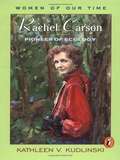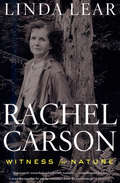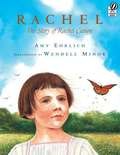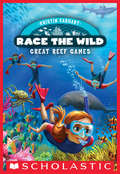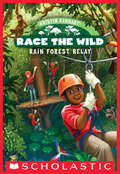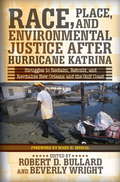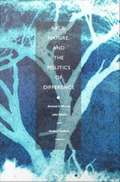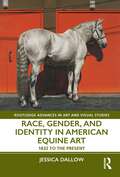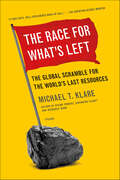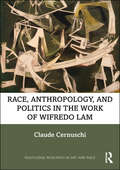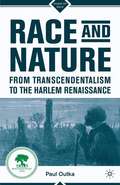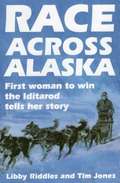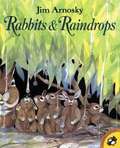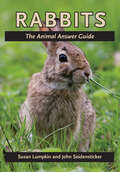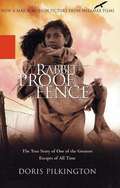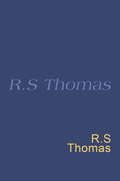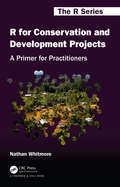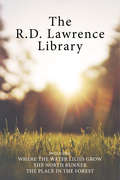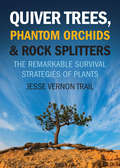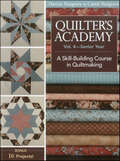- Table View
- List View
Rachel Carson Preserving a Sense of Wonder: Preserving A Sense Of Wonder (Images Of Conservationists Ser.)
by Joseph Bruchac Thomas LockerA biography of Rachel Carson interspersed with her own memorable quotes.
Rachel Carson and Ecology for Kids: Her Life and Ideas, with 21 Activities and Experiments (For Kids series)
by Rowena RaeRachel Carson was an American biologist, conservationist, science and nature writer, and catalyst of the modern environmental movement. She studied biology in college at a time when few women entered the sciences, and then worked as a biologist and information specialist for the US government and wrote about the natural world for many publications. Carson is best remembered for her book Silent Spring, which exposed the widespread misuse of chemical pesticides in the United States and sparked both praise and fury. Carson's personal life and scientific career were rooted in the study of nature. Using examples from Carson's life and works, Rachel Carson and Ecology for Kids will introduce readers to ecology concepts such as the components of ecosystems, adaptations by living things, energy cycles, food chains and food webs, and the balance of ecosystems. This lively biography includes a time line, resources, sidebars, and 21 hands-on activities that are sure to inspire the next generation of scientists, thinkers, leaders, agricultural producers, environmental activists, and world citizens. Kids will:Collect a seed bank of local plant speciesChart bird migration through their regionMake birdseed cookiesModel bioaccumulation and biomagnificationBuild a worm farmAnd more!
Rachel Carson
by Kathleen V. KudlinskiRachel Carson--scientist, author, and environmentalist Rachel Carson was always fascinated by the ocean. As a child, she dreamed of it and longed to see it. As a young woman, she felt torn between her love for nature and her desire to pursue a writing career. Then she found a way to combine both. Rachel had a talent for writing and talking about science in a way that everyone could understand and enjoy. With her controversial book, Silent Spring, Rachel Carson changed the way we look at our planet. "Kudlinski has admirably captured the driving force of spirit of a shy but courageous woman in a succinct, respectful approach."--Booklist About the Women of Our Time series: International in scope, the Women of Our Time series of biographies cover a wide range of personalities in a variety fields. More than a history lesson, these books offer carefully documented life stories that will inform, inspire, and engage.
Rachel Carson: Witness for Nature
by Linda LearThe authoritative biography of the marine biologist and nature writer whose book Silent Spring inspired the global environmentalist movement. In a career that spanned from civil service to unlikely literary celebrity, Rachel Carson became one of the world&’s seminal leaders in conservation. The 1962 publication of her book Silent Spring was a watershed event that led to the banning of DDT and launched the modern environmental movement. Growing up in poverty on a tiny Allegheny River farm, Carson attended the Pennsylvania College for Women on a scholarship. There, she studied science and writing before taking a job with the newly emerging Fish and Wildlife Service. In this definitive biography, Linda Lear traces the evolution of Carson&’s private, professional, and public lives, from the origins of her dedication to natural science to her invaluable service as a brilliant, if reluctant, reformer. Drawing on unprecedented access to sources and interviews, Lear masterfully explores the roots of Carson&’s powerful connection to the natural world, crafting a &“fine portrait of the environmentalist as a human being&” (Smithsonian). &“Impressively researched and eminently readable . . . Compelling, not just for Carson devotees but for anyone concerned about the environment.&” —People &“[A] combination of meticulous scholarship and thoughtful, often poignant, writing.&” —Science &“A sweeping, analytic, first-class biography of Rachel Carson.&” —Kirkus Reviews
Rachel Carson
by Ellen Jean PetersRachel Carson by Ellen Jean Peters illustrated by Jerry Tiritilli
Rachel
by Amy EhrlichRachel Carson was always curious about the world around her. As a girl, she loved being outside, exploring and learning more about the universe. As an adult, Rachel wrote books, including Silent Spring, considered to be the start of today's environmental movement. An epilogue highlights on Rachel Carson's work and life.
Race the Wild #2: Great Reef Games (Race the Wild #2)
by Kristin EarhartSage is used to being the fastest runner, the quickest climber, and the strongest swimmer around. And she's also used to taking charge. But when the second race course has the red team diving underwater to explore the Great Barrier Reef, it's trusting her teammates that matters most. It's sink or swim time.... Each chapter in this action-packed adventure series is bursting with totally true facts about wild and wonderful creatures, dangerous habitats, maps, and more!
Race the Wild #1: Rain Forest Relay (Race the Wild #1)
by Kristin EarhartWhen Russell entered the race, he knew it was going to be a wild ride. Especially the first race course! He'd been studying up on the Amazon's animals and culture forever. But nothing could prepare him or his teammates for what they'd find in the rain forest: raging rapids, poisonous venom, and sneaky competitors who'd do anything to win. Can the red team work together to make it to the finish line in one piece? Each chapter in this action-packed adventure series is bursting with totally true facts about wild and wonderful creatures, dangerous habitats, maps, and more!
Race, Place, and Environmental Justice After Hurricane Katrina
by Robert D. Bullard Beverly WrightOn August 29, 2005, Hurricane Katrina made landfall near New Orleans leaving death and destruction across the Louisiana, Mississippi, and Alabama Gulf Coast counties. The lethargic and inept emergency response that followed exposed institutional flaws, poor planning, and false assumptions that are built into the emergency response and homeland security plans and programs. Questions linger: What went wrong? Can it happen again? Is our government equipped to plan for, mitigate, respond to, and recover from natural and manmade disasters? Can the public trust government response to be fair? Does race matter? Racial disparities exist in disaster response, cleanup, rebuilding, reconstruction, and recovery. Race plays out in natural disaster survivors' ability to rebuild, replace infrastructure, obtain loans, and locate temporary and permanent housing. Generally, low-income and people of color disaster victims spend more time in temporary housing, shelters, trailers, mobile homes, and hotels--and are more vulnerable to permanent displacement. Some "temporary" homes have not proved to be that temporary. In exploring the geography of vulnerability, this book asks why some communities get left behind economically, spatially, and physically before and after disasters strike.
Race, Nature, and the Politics of Difference
by Donald S. Moore Jake Kosek Anand PandianHow do race and nature work as terrains of power? From eighteenth-century claims that climate determined character to twentieth-century medical debates about the racial dimensions of genetic disease, concepts of race and nature are integrally connected, woven into notions of body, landscape, and nation. Yet rarely are these complex entanglements explored in relation to the contemporary cultural politics of difference. This volume takes up that challenge. Distinguished contributors chart the traffic between race and nature across sites including rainforests, colonies, and courtrooms. Synthesizing a number of fields--anthropology, cultural studies, and critical race, feminist, and postcolonial theory--this collection analyzes diverse historical, cultural, and spatial locations. Contributors draw on thinkers such as Fanon, Foucault, and Gramsci to investigate themes ranging from exclusionary notions of whiteness and wilderness in North America to linguistic purity in Germany. Some essayists focus on the racialized violence of imperial rule and evolutionary science and the biopolitics of race and class in the Guatemalan civil war. Others examine how race and nature are fused in biogenetic discourse--in the emergence of "racial diseases" such as sickle cell anemia, in a case of mistaken in vitro fertilization in which a white couple gave birth to a black child, and even in the world of North American dog breeding. Several essays tackle the politics of representation surrounding environmental justice movements, transnational sex tourism, and indigenous struggles for land and resource rights in Indonesia and Brazil. Contributors. Bruce Braun, Giovanna Di Chiro, Paul Gilroy, Steven Gregory, Donna Haraway, Jake Kosek, Tania Murray Li, Uli Linke, Zine Magubane, Donald S. Moore, Diane Nelson, Anand Pandian, Alcida Rita Ramos, Keith Wailoo, Robyn Wiegman
Race, Gender, and Identity in American Equine Art: 1832 to the Present (Routledge Advances in Art and Visual Studies)
by Jessica DallowThis book traces an evolution of equine and equestrian art in the United States over the last two centuries to counter conventional understandings of subjects that are deeply enmeshed in the traditions of elite English and European culture. In focusing on the construction of identity in painting and photography—of Blacks, women, and the animals themselves involved in horseracing, rodeo, and horse show competition—it illuminates the strategic and varying roles visual artists have played in producing cultural understandings of human-animal relationships. As the first book to offer a history of American equine and equestrian imagery, it shrinks the chasm of literature on the subject and illustrates the significance of the genre to the history of American art. This book further connects American equine and equestrian art to historical, theoretical, and philosophical analyses of animals and attests to how the horse endures as a vital, meaningful subject within the art world as well as culture at large. This book will be of interest to scholars in art history, American art, gender studies, race and ethnic studies, and animal studies.
The Race for What's Left: The Global Scramble for the World's Last Resources
by Michael T. KlareFrom Michael Klare, the renowned expert on natural resource issues, an invaluable account of a new and dangerous global competitionThe world is facing an unprecedented crisis of resource depletion—a crisis that goes beyond "peak oil" to encompass shortages of coal and uranium, copper and lithium, water and arable land. With all of the planet's easily accessible resource deposits rapidly approaching exhaustion, the desperate hunt for supplies has become a frenzy of extreme exploration, as governments and corporations rush to stake their claim in areas previously considered too dangerous and remote. The Race for What's Left takes us from the Arctic to war zones to deep ocean floors, from a Russian submarine planting the country's flag on the North Pole seabed to the large-scale buying up of African farmland by Saudi Arabia, China, and other food-importing nations.As Klare explains, this invasion of the final frontiers carries grave consequences. With resource extraction growing more complex, the environmental risks are becoming increasingly severe; the Deepwater Horizon disaster is only a preview of the dangers to come. At the same time, the intense search for dwindling supplies is igniting new border disputes, raising the likelihood of military confrontation. Inevitably, if the scouring of the globe continues on its present path, many key resources that modern industry relies upon will disappear completely. The only way out, Klare argues, is to alter our consumption patterns altogether—a crucial task that will be the greatest challenge of the coming century.
Race, Anthropology, and Politics in the Work of Wifredo Lam (Routledge Research in Art and Race)
by Claude CernuschiThis book reinterprets Wifredo Lam’s work with particular attention to its political implications, focusing on how these implications emerge from the artist’s critical engagement with 20th-century anthropology. Field work conducted in Cuba, including the witnessing of actual Afro-Cuban religious ritual ceremonies and information collected from informants, enhances the interpretive background against which we can construe the meanings of Lam's art. In the process, Claude Cernuschi argues that Lam hoped to fashion a new hybrid style to foster pride and dignity in the Afro-Cuban community, as well as counteract the acute racism of Cuban culture.
Race and Nature from Transcendentalism to the Harlem Renaissance
by Paul OutkaDrawing on theories of sublimity, trauma, and ecocriticism, this book examines how the often sharp division between European American and African American experiences of the natural world developed in American culture and history, and how those natural experiences, in turn, shaped the construction of race.
Race Across Alaska: First Woman to Win the Iditarod Tells Her Story
by Libby Riddles Tim JonesLibby Riddles wanted an adventure. At age 16 she left home for the snowy wilderness of Alaska, the Last Frontier. There her love of animals drew her to the sport of sled dog racing. When she entered the Iditarod, the famous marathon from Anchorage to Nome, she was just another Iditarod Nobody. Twelve hundred miles later, having conquered blizzards, extreme cold, and exhaustion, she and her dogs crossed the final stretch of sea ice, miles ahead of the nearest competitor... and suddenly she realized: I will be the first woman to win the Iditarod. This is the story of a courageous woman and her heroic dogs. This is the story of Libby Riddles's adventure.
Raccoons and Their Relatives (World Book's Animals of the World)
by Pat Harvey SullivanDo raccoons wear masks? What's special about a raccoon's "hands"? Do raccoons wash their food? Do raccoons hibernate in winter? Find out all about the physical characteristics, habits, and behavior of raccoons and such related species as the coati, kinkajou, red panda, and ringtail.
Rabbits And Raindrops
by Jim ArnoskyIt's the first day outside the nest for Mother rabbit's five babies, and all sorts of new creatures and adventures await them. But when a sudden rain shower sends the rabbits scurrying for shelter under the hedge, the other wild animals come to visit them! Jim Arnosky's graceful watercolors and simple text are sure to delight children experiencing nature's wonders for the first time.
Rabbits: The Animal Answer Guide (The Animal Answer Guides: Q&A for the Curious Naturalist)
by Susan Lumpkin John SeidenstickerDid you know that there are more than 90 species of rabbits, hares, and pikas, rabbits' little-known cousins? And that new species are still being found? Or that baby rabbits nurse from their mothers only once a day? How about that some people brew medicinal tea from rabbit pellets? Wildlife conservationists Susan Lumpkin and John Seidensticker have all the answers—from the mundane to the unbelievable—about the world’s leaping lagomorphs. To some, rabbits are simply a docile pet for the classroom or home. To others, they are the cute animals munching on clover or the pests plaguing vegetable gardens. Whatever your interest, in Rabbits: The Animal Answer Guide you will discover that they are a more complex group than you might have first imagined. Lumpkin and Seidensticker take these floppy-eared creatures out of the cabbage patch and into the wild, answering 95 frequently asked questions about these familiar and fascinating animals.With informative photographs and an accessible format, Rabbits: The Animal Answer Guide is the one resource you will need to learn about rabbits' anatomy and physiology, evolutionary history, ecology, behavior, and their relationships with humans. Lumpkin and Seidensticker also talk about conservation, because while rabbits may breed like, well, rabbits, several species are among the most endangered animals on Earth.
Rabbit-Proof Fence
by Doris Pilkington Nugi GarimaraTHE REMARKABLE TRUE STORY OF THREE YOUNG GIRLS WHO CROSS THE HARSH AUSTRALIAN DESERT ON FOOT TO RETURN TO THEIR HOME. Following an Australian government edict in 1931, black aboriginal children and children of mixed marriages were gathered up by whites and taken to settlements to be assimilated. In Rabbit-Proof Fence, award-winning author Doris Pilkington traces the captivating story of her mother, Molly, one of three young girls uprooted from her community in Southwestern Australia and taken to the Moore River Native Settlement. At the settlement, Molly and her relatives Gracie and Daisy were forbidden to speak their native language, forced to abandon their aboriginal heritage, and taught to be culturally white. After regular stays in solitary confinement, the three girls-scared and homesick-planned and executed a daring escape from the grim camp, with its harsh life of padlocks, barred windows, and hard cold beds. The girls headed for the nearby rabbit-proof fence that stretched over 1000 miles through the desert toward their home. Their journey lasted over a month, and they survived on everything from emus to feral cats, while narrowly avoiding the police, professional trackers, and hostile white settlers. Their story is a truly moving tale of defiance and resilience.
Rabbit Breeds: The Pocket Guide to 49 Essential Breeds
by Lynn M. StoneRabbits are the third-most popular pet in the United States and have also earned significant farming and commercial followings: fiber enthusiasts love angora for its light-weight warmth, and chefs are serving up increasing amounts of their high-protein, low-fat meat. In Rabbit Breeds, photographer Lynn M. Stone spotlights all 49 breeds recognized by the American Rabbit Breeders Association with adorable original photos, engaging descriptions, and fun facts. This handsome and educational guide is sure to inform and bring a smile to the face of rabbit fanciers and general animal lovers alike.
R. S. Thomas: Everyman Poetry
by rev R.S. ThomasA best of R.S. Thomas's poems in a beautiful new gift editionR. S. Thomas (1913- 2000) was born in Cardiff. He studied classics, then theology and, after ordination, served six rural Welsh parishes for most of his life. His first book of poems was published in 1946. He won the Queen's Gold Medal for Poetry in 1964 and published regularly, Collected Poems 1945-90 marking his eightieth birthday.
R for Conservation and Development Projects: A Primer for Practitioners (Chapman & Hall/CRC The R Series)
by Nathan WhitmoreThis book is aimed at conservation and development practitioners who need to learn and use R in a part-time professional context. It gives people with a non-technical background a set of skills to graph, map, and model in R. It also provides background on data integration in project management and covers fundamental statistical concepts. The book aims to demystify R and give practitioners the confidence to use it. Key Features:• Viewing data science as part of a greater knowledge and decision making system • Foundation sections on inference, evidence, and data integration • Plain English explanations of R functions • Relatable examples which are typical of activities undertaken by conservation and development organisations in the developing world • Worked examples showing how data analysis can be incorporated into project reports
The R.D. Lawrence Library: Where the Water Lilies Grow / The North Runner / The Place in the Forest
by R. D. Lawrence Max FinkelsteinThis special 3-book bundle collects three of the works of master nature writer R.D. Lawrence. In The North Runner, he tells the true and moving story of the building of trust between a man and an exceptional dog that was half wolf, half Alaskan Malamute, and the resulting mutual affection and respect between them. In The Place in the Forest, he tells of a patch of Ontario wilderness, soon known as "The Place." Here Lawrence and his wife built a cabin and became immersed in studying the ways of the wild. "The Place" was home to a variety of wildlife, from black bears, wolves, beavers and raccoons through to hawks, snapping turtles and singing mice. Lawrence’s desire to learn, fuelled by his keen observation, led to his writing about and photographing life within his small corner of the forest — the result being a warm, witty account of change and survival in the natural world. The sequel, Where the Water Lilies Grow, continues the story of animals who inhabit the lakeside near his backwoods home. From the smallest water creature to wolves, deer and many, many birds, all are known to him with sensitivity, enthusiasm and empathy. Includes The North Runner The Place in the Forest Where the Water Lilies Grow
Quiver Trees, Phantom Orchids & Rock Splitters: The Remarkable Survival Strategies of Plants
by Jesse Vernon Trail&“Showcases the many weird and wonderful ways plants adapt to survive and spread their progeny . . . A great book for anyone interested in botany&” (The Gardener). Whether it&’s an arctic heather that can create subtropical conditions within its leaves, or a dwarf mistletoe that can shoot its seeds up to fifty feet away, plants demonstrate remarkable strategies in coping with and surviving their environments. Plants are often exposed to bitter cold, relentless winds, intense heat, drought, fire, pollution, and many other adverse growing conditions. Yet they are still able to survive and often even thrive. This book showcases these exceptional plants with absorbing information and stunning photos that will inspire a new respect for nature&’s innovation and resilience. &“From hummingbirds on the high slopes of the Andes to sugarbirds on the South African Cape, Vernon takes the reader on an awe-inducing journey to discover the secret life of pollinators and the plants that depend upon them. . . . You&’ll delight in the surprising, unusual, and downright amazing strategies plants use to cope and copulate.&” —Sierra
Quilter's Academy—Senior Year: A Skill Building Course in Quiltmaking
by Harriet Hargrave Carrie HargraveYour senior year is a star-filled adventure! Your senior year of Quilter's Academy takes you into the most exciting of all designs-stars! You'll explore a variety of more complex piecing techniques such as Y-seams and partial seams, which put the sewing and pressing skills you've learned thus far to the test. Work through the lessons at your own pace and soon you will be making those really stunning quilts that you never thought you could make! • The fourth installment in this popular university-style series • Build upon the skills you developed in the first three volumes to learn how to make beautiful stars, as well as other more complex blocks and piecing techniques • Fill your creative toolbox with new techniques that allow you to enjoy the process of quiltmaking even more!


